anth g6085

matter strikes back:
an experiment with bamana boli [1]
katie skaggs (columbia university)
Finally allowed to relax, to just be themselves, objects sink into themselves, weary of form; they consider sinking into an amorphous heap…
— Bill Brown (2005:15).
hh
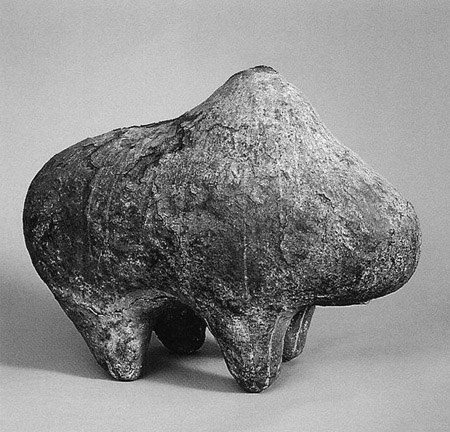 kk
kk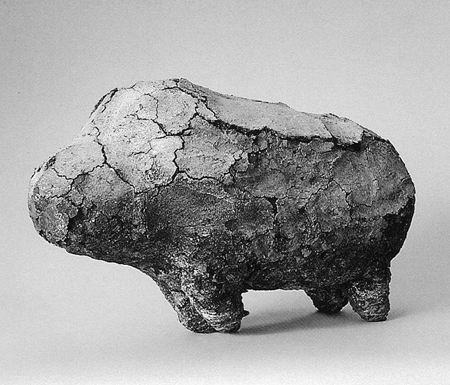
ff
For the Bamana of West Africa, as socio-cultural (and I might add quite functionalist) arguments would have it, it is the various professional groups, nyamakalaw, that promote social and political cohesion. Jow, the collective name for the secret societies, brotherhoods, or initiation associations, are defined according to their object relations as “institutions that wield power [nyama] by concentrating it into material objects (boliw) and launching it, under control, out into the world” (Colleyn 2001: 168). Komo, a secret male initiation society of priests, elders and blacksmiths form the central nexus of these social institutions and are the sole actors in the formation and dealings of the boliw. They are experts in the transformation and manipulation of the formless- dealers in the excesses of dangerous materials.
Nevertheless, I do not wish to over-emphasize the culture-object space where we find “subjects making objects making subjects” (Pinney 2005: 269) although that is not to reject that Bamana boli objects have this social power of reproduction and stabilization that has been commented upon and analyzed at length elsewhere. It is an argument that instead calls for the rejection of the insistence on the indexicality of the object, where “images are not simply, always, a reflection of something happening elsewhere” (Pinney 2005: 266). Instead, I will argue for matters of matter- the potency of materials outside of subject/object relationships– and that which “exceeds their mere materialization as objects or their mere utilization as objects…” (Brown 2001: 5). It is then also an argument against ideal notions of matter or consumption that leave no remains and focuses instead on the “wavy meaning” of objects, the vaporous vibrations given off by the object as lurking spaces that are left un-incorporated, un-digested into things; “cataracts of objects never fully assimilable to any ‘context’” (Pinney 2005: 269).
h
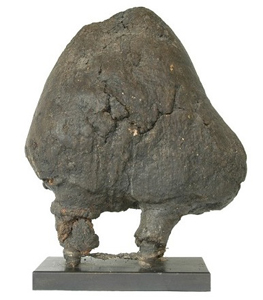
g
Dark foliage of the wooded ‘bush,’ the secret, sacred forest closes in on a small mud dwelling. Inside on a platform, sits various headdresses. A drop of salty sweat slips from the face of a blacksmith received by the surface of a larger amorphous, bulbous boli figure and adding to the multiple hardened and cracking layers of encrustations. Animal bones, vegetable matter, honey, and metal seem to burst, packed so tightly around an interior armature of bamboo and wood wrapped in layers of stiff white cotton cloth. Layers of abject and base materials are accumulated on this altar, tightly packed together with a mixture of water from a freshly dug well and a hard, thick patina of earthly elements, detritus - mud and black clay - the surfaces are impregnated with sacrificial materials over time: spit, urine and human excrement, chicken and goat blood, women’s menstrual cloths, chewed kola nuts, beer, palm wine and other alcohol, butter, millet porridge, antelope horns, tusks, porcupine quills, animal hair, bird skulls, jawbones, feathers, fibers, cotton, wood, bark, tree roots, herbs, grasses, organic materials, nails, precious metals including gold, mirrors and amorphous, unidentifiable and undocumented material bundles are added to the surface. The boli, usually sculpted in the vague zoomorphic form of a bovine[2] becomes more amorphous with each initiation offering, obscuring its original form and taking on a shape of its own as materials accumulate and morph in a thick patina. The amorphous forms and unusual materials coalesce in ambiguity, tightly restraining materials, ensuring that an easy semiotic or functionalist reading of the object is not evident; the accumulated layers seek to contain, conceal, obscure the transgressive dangers of its contagion. Yet the bulging surface discloses the presence of something more.
Georges Bataille is interested in analyzing this something more, these excessive and formless spaces- epitome of that which eludes classification- in his writings on base material. Bataille’s argument in opposition to classical, idealist, regulated form in “Le cheval academique” calls for the disintegration of the Greek academic horse into formless, monstrous beasts depicted on Gaulish coins whose heads, legs and body explode into the ecstatic, incoherent shapes,” (Cheng 2003); He elaborates against the tendency towards an architecture of petrifaction in favor of a sensuous and liquefied formlessness: “…That…has no claim in any sense and is always trampled upon like a spider or an earthworm….To declare…that the universe is not like anything, and is simply formless, is tantamount to saying that the universe is something like a spider or spittle” (Documents 7, 1929 in Awdes 2006: 92).
hh
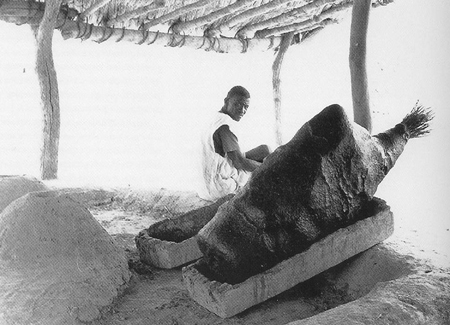
hh
In the same issue of Bataille’s Documents, where he offers his definitions of the “informe” ethnographers Michel Leiris and Marcel Griaule before embarking on their Mission Dakar-Djibouti across Africa each devoted a brief entry to this excess, formless spittle. Spittle, ambiguous, dangerous and sacred “is like the soul” Griaule states: “balm or garbage” (Griaule in Clifford 1988: 133). Leiris elaborates, adding another thick layer onto Griaule’s definitions “spittle is the permanent spermlike sullying of the noble mouth, an organ associated in the West with intelligence and language. Spit thus re-symbolized denotes a condition of inescapable sacrilege” (Leiris in Clifford 1988:133). Sartre likewise speaks of this viscosity as a transgressive, dangerous and contagious zone of contact- a space where the subject risks losing themselves to the object: “It is unstable, but it does not flow. It is soft, yielding and compressible. There is no gliding on its surface. Its stickiness is a trap, it clings like a leech; it attacks the boundary between myself and it. Long columns falling off my fingers suggest my own substance flowing into a pool of stickiness… to touch stickiness is to risk diluting myself into viscosity” (Sartre in Douglas in Gell 1998: 82).
What if these fluid and viscous bodily borders of the subject were expanded to objects? What if the receiving agents of these tacky excesses are not human but other things? What if we were to look at these excretions of objects not as a product of the “accursed share” of the subject but a distributed “objecthood”? What would this guerilla metaphysics of the interrelations of objects look like? A fetishism dangerously out of touch with reality? Perhaps-but one charged with the possibilities of a more radical position, nevertheless.
h
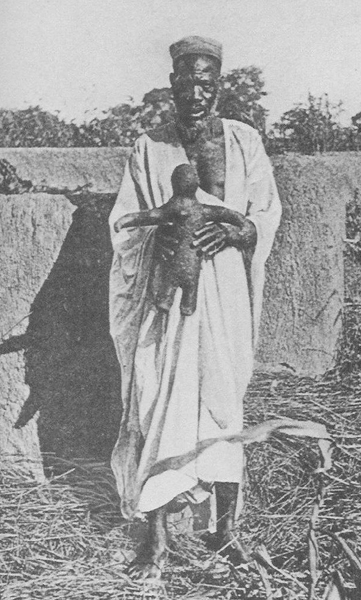 lklklkl
lklklkl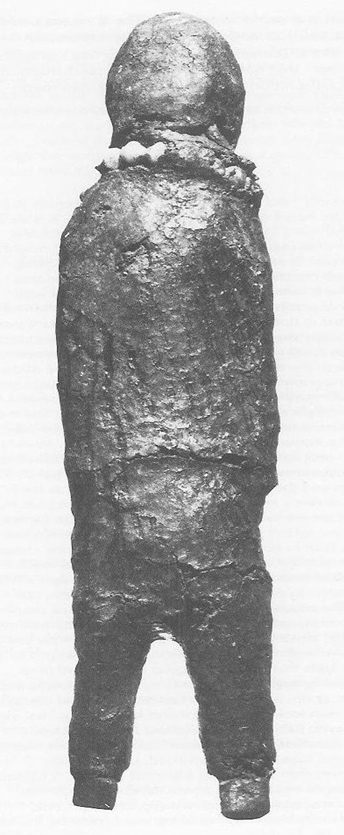
hh
Likewise, the heterogeneous matter of the boli cannot be entirely reduced to the durable object, instead its surfaces breath- expanding, reflecting, flowing, mixing, absorbing, contracting, “generated and dissolved within the fluxes of materials across the interface between substances and the medium that surrounds them” (Ingold 2007: 1) Try as one might, “…The object fails to keep its distance, abandons its reserve, overflows…” (Hollier 1992: 17). Ingold elaborates on this flux of materials: “they are relentlessly on the move – flowing, scraping, mixing and mutating. The existence of all living organisms is caught up in this ceaseless respiratory and metabolic interchange between their bodily substances and the fluxes of the medium.” (Ingold 2007: 11)
With continual accumulative offerings, the power of the object is renewed, expanded. Alcohol is spilled over the surface of the boli, the dried mud soaks in, absorbs the offering- oozing back, secreting the stickiness of honey pregnant with a viscous and dangerous contagion embodied within and yet seeping from the surfaces of materials.
Another object nearby- another boli or a komo kun or initiation masks slowly swallow up, consume the excess of materials from the boli- emanations of fouls smells sink through the surface pores of the mask and scattered matter- feathers, dust, and other materials are carried with the whisping winds attached to the tar-like surface- into their more shallowly encrusted surfaces- small bundles of bird skulls, vulture feathers, porcupine quills shiver at the contact, attached by a similar layering of elements- clay, leaves, powdered minerals, powdered bone, masticated millet, sacrificial blood.
The materials and their interactions within the boli- the material “dematerialization,” decompositions, disappearances, dissolutions, corruptions, corrosions, crumblings- these persist even after the embodied contact with humans has ceased. These encrusted traces of the boli are not merely indexical of an immaterial or socio-cultural condition but are an inherent and embodied excess emitted from the material object itself “like smoke which logs of oak, heat and fire emit; some of a closer and denser texture, like the gossamer coats which at times cicadas doff off at summer, and the film which calves at their birth cast from the surface of their body, as well as the vesture which the slippery serpent puts off among the thorns; for often we see the brambles enriched with their flying spoils, since these cases occur, a thin image likewise must be emitted from things off their surface” (Lucretius in Gell 1998: 105).
references
Ades, Dawn and Simon Baker. 2006. Undercover Surrealism: Georges Bataille and Documents. Cambridge, MA: The MIT Press.
Brown, Bill. 2001. “Thing Theory.” Critical Inquiry 1: 1-22.
Clifford, James. 1988. The Predicament of Culture: Twentieth Century Ethnography, Literature and Art. Cambridge: Harvard University Press.
-Colleyn, Jean- Paul, ed. 2001. Bamana: The Art of Existence in Mali. New York: Museum for African Art.
Gell, Alfred. 1998. Art and Agency: An Anthropological Theory. Oxford: Clarendon Press.
Hollier, Denis and Leisl Ollman. 1992. “The Use-Value of the Impossible” October, 60: 3-24.
Ingold, Tim. 2007. “Materials against materiality” Archaeological Dialogues 14:1 16.
Pinney, Christopher. 2005. “Things Happen: Or, From Which Moment Does that Object Come?” Materiality. Durham: Duke University Press. Pp. 256-272.
Pels, Peter. 1998. “The spirit of matter: on fetish, rarity, fact and fancy.” Border Fetishisms: Material Objects in Unstable Spaces. Routledge, New York pp. 91 121.
ggg
works consulted
Bataille, Georges, Michel Leiris, Carl Einstein, and Marcel Griaule. 1992. “Critical Dictionary.” Translated by Dominic Faccini. October, Vol. 60, Spring, pp.25 31.
Brett- Smith, Sarah C. 2002. “Bamana Identity, State Formation, and the Sources of Bamana Art.” American Anthropologist 104 (3): 939-944.
Brett- Smith, Sarah C. 1997. “Mouth of the Komo.” Res 31: 71-96.
Brett-Smith, Sarah C. 1996. The Artfulness of M’Fa Jigi: An Interview with Nyamaton Diarra. African Studies Program, University of Wisconsin-Madison.
Brett- Smith, Sarah C. 1994. The Making of Bamana Sculpture: creativity and gender. Cambridge; New York: Cambridge University Press.
Brett- Smith, Sarah C. 1983. “Poisonous Child” Res 6: 47-64.
Brett-Smith, Sarah C. 1982. “Symbolic Blood: Cloths for Excised Women.” Res 5: 12- 51.
Deiterlen, Germaine and Y. Cisse. 1972. Les Fondements de la Société d’Initiation Du Komo. Paris: Mouton & Co.
Dieterlen, Germaine. 1951. Essai Sur La Religion Bambara. Paris: Presses Universitaires de France.
Ezra, Kate. 1986. A Human Ideal in African Art: Bamana Figurative Sculptures. Washington D.C.: Published for National Museum of African Art by Smithsonian Institution Press.
Ezra, Kate. 1984. “Early Sources for the History of Bamana Art.” Iowa Studies in African Art. Anes 1: 147-166.
McNaughton, Patrick R. 1988. The Mande Blacksmiths: Knowledge, Power, and Art in West Africa. Indianapolis: Indiana University Press.
McNaughton, Partick R. 1979. Secret Sculptures of Komo: Art and Power in Bamana (Bambara) Initiation Associations. Philadelphia: ISHU (Institute for the Human Issues).
McNaughton, Patrick R. 1979. “Bamana Blacksmiths.” African Arts 12 (2): 65-71.